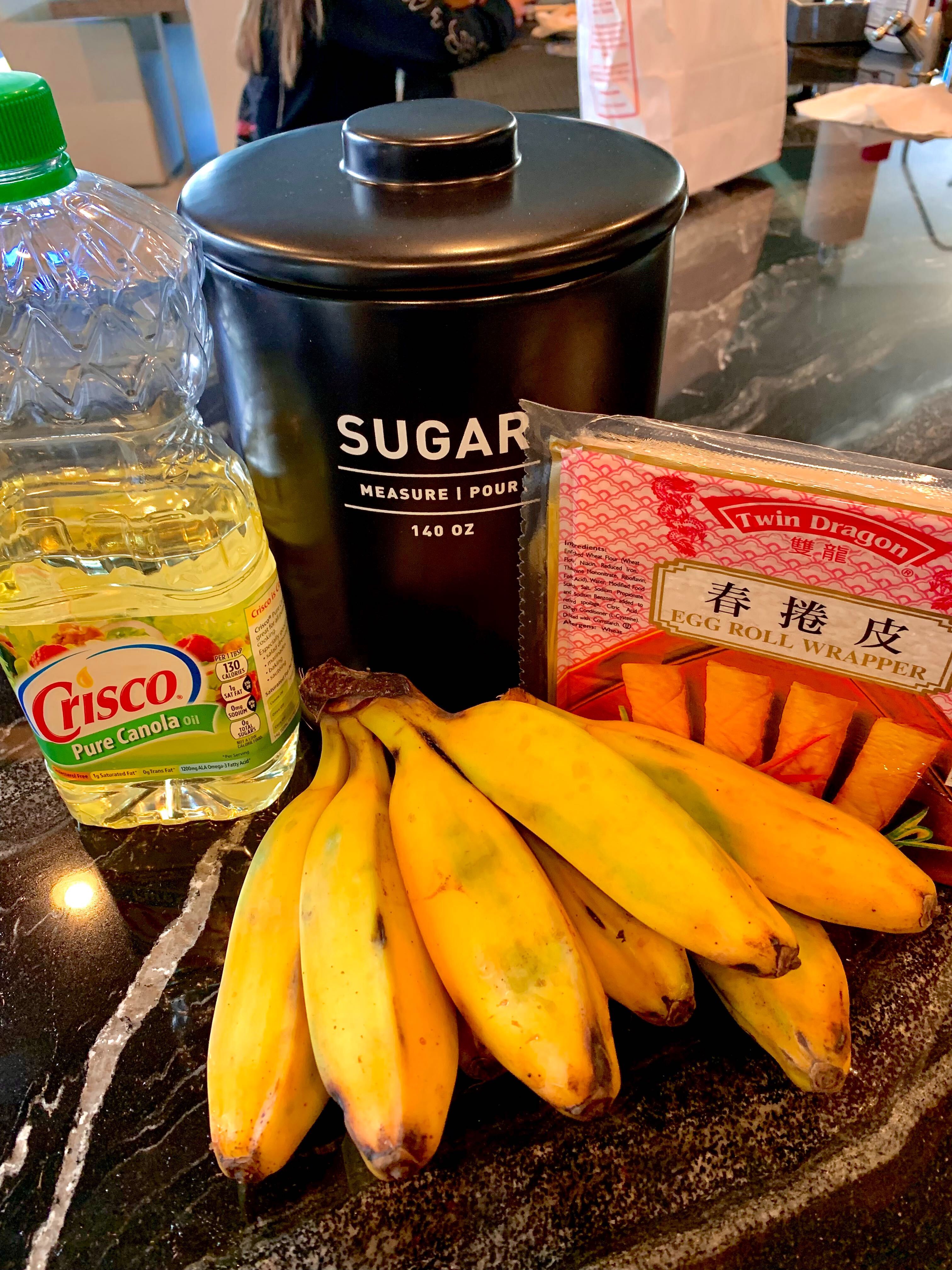
Ingredients
- 6 bananas (plantains)
- 24 egg roll/lumpia wrappers
- ¼ cup brown sugar
- Oil
- 1 tsp flour
- 1 tbsp water
Growing up, I don’t believe I took part in the idea that is traditional Thanksgiving. The hallways at home were never lined with the wonky-shaped hand turkeys I made at school. Never in my life have I seen a single float at the Macy’s Day Parade. And the biggest difference of all, to me, was the food. The table, covered with the fancy white linen tablecloth only taken out for the holidays, was never piled up with the staples my friends at school seemed to have at their dinners.
Where was the mac and cheese? The mashed potatoes? No stuffing? What about the turkey?
When I was eleven years old, these were the very important questions I would always ask. The only thing that seemed to matter at all during Thanksgiving was the food. But I was always stuck with eating Filipino food that none of my friends had heard of. There was pancit and puto. Buko pandan and halo-halo. Despite this, a personal favorite of mine was my grandmother’s banana lumpia.
1. Peel the bananas, and cut the tops and bottoms.

The lumpia was something I looked forward to every Thanksgiving. The smell of the sugar and the bananas would waft through the air and fill the whole room. The flaky textures of the wrap would melt in my mouth and balance out the gooeyness of the filling inside. It was the only thing I wouldn’t dread bringing to school the next couple of days as Thanksgiving leftovers in front of my friends.
2. Cut the bananas again half lengthwise.

The early parts of my life, elementary through middle school, were spent in a predominantly white school. While there were other Asian peers, I was the only Filipino student in my grade. All my friends would talk about their Thanksgivings and show off their hefty leftover meals. They would talk about spending time with their great aunts and uncles or their second and third cousins. My Thanksgiving was nothing like theirs.
3. Gather the wrapper, the sugar, and the banana.
My friends basically had entire family reunions with people all over the country. Meanwhile, my Thanksgiving usually consisted of my brother, mom, dad (if he wasn’t at work), grandmother and a couple of close aunts, uncles and cousins. However, that’s still a lot more than some other Asian American households. It is quite common for those parts of the community to keep Thanksgiving within the nuclear family as many are first or second-generation Americans. Their relatives tend to be back in their home countries.
4. Roll each banana in a plate of brown sugar.

Now a lot of those other Asian American households would do a mix of the traditional Thanksgiving foods with other foods from their own culture. Mine, however, stuck to purely Filipino foods and that would be only a couple of dishes. It wasn’t like the feasts my friends would have. They would stuff themselves full with warm turkey and buttery mashed potatoes. I would eat cold noodles. My only highlight was the banana lumpia.
5. On a plate, have a corner of the wrapper face you. Then, place the banana about two inches away from said corner. Fold the bottom corner over the banana and roll about halfway. Tightly fold the right and left corners into the middle. Keep rolling until there is little space left in the last corner. Add the paste to seal the final corner. Repeat with the remaining ingredients.
I felt like I couldn’t relate to my friends. My Thanksgivings were always small and not much of a party. Back then, I felt like my family dinner was lonely. Now, I realize that the dinner wasn’t small; it was intimate. The people who mattered to me were there. None of the food we had was bought pre-made from a grocery store or a restaurant. Every single dish we were able to have was made with love, as cliche as that sounds. This food was what brought us together for Thanksgiving.
6. Heat the oil in a pan at about 350 degrees Fahrenheit. Add in the lumpia and fry until golden brown, about five minutes.

What made me love the lumpia so much apart from the delicious sweet taste was how much effort I knew my grandmother put into it. I have so many fond memories of her in her kitchen folding each individual wrap. With her gentle hands, she would carefully dip the bananas in sugar and slowly lower them into the fryer. She would spend hours doing this tedious task back and forth for hours because she knew how much the family loved them. That open expression of caring for the family to me is what makes Thanksgiving so special.
7. Remove the banana lumpia, and drain the excess oil on a baking sheet.

While I have never had Thanksgiving in what some might deem to be the traditional sense, I have taken part in the way that matters. Like the theme of Thanksgiving, lumpia is also about hospitality. We celebrate Thanksgiving as a reason to be around those we are thankful for. Well, in Filipino culture, lumpia is a symbolic way to express how we enjoy having our people here with us. The wrappers hold together the combination of the bland plantains and sweet brown sugar, melding them into a delicious harmonious treat.
I realize now as an adult how Thanksgiving is so much more than the traditions and the food. It’s about our cherished time with one another and how we need to be thankful for the ones we love who are with us. Thanksgiving can be celebrated in many different ways, by many different people, but the message of being together is present for us all. And now it’s time for the final step.
8. Serve and enjoy.



Comments are closed.